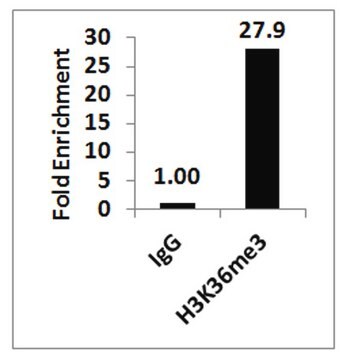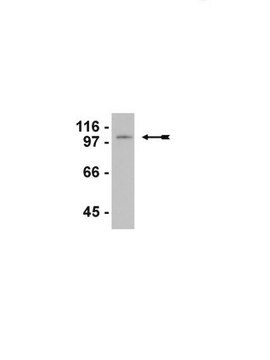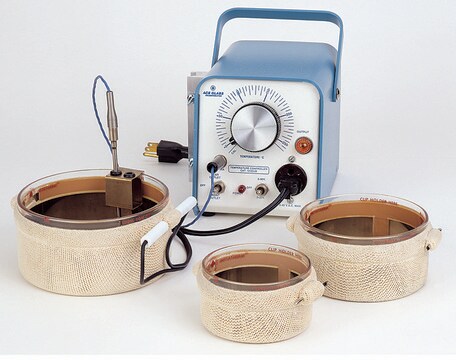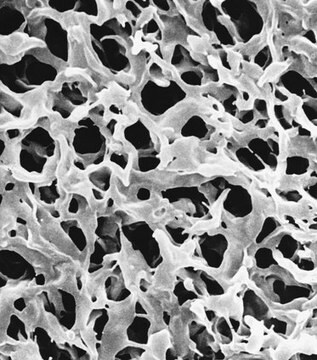17-10531
ChIPAb+ LSD1 (KDM1A) Antibody - ChIP Validated Antibody and Primer Set
from rabbit, purified by affinity chromatography
Synonim(y):
Lysine-specific histone demethylase 1A, BRAF35-HDAC complex protein BHC110, Flavin-containing amine oxidase domain-containing protein 2
About This Item
Polecane produkty
pochodzenie biologiczne
rabbit
Poziom jakości
klon
polyclonal
oczyszczone przez
affinity chromatography
reaktywność gatunkowa
rat, human, mouse
producent / nazwa handlowa
ChIPAb+
Upstate®
metody
ChIP: suitable
immunoprecipitation (IP): suitable
western blot: suitable
numer dostępu NCBI
numer dostępu UniProt
Warunki transportu
dry ice
Opis ogólny
The ChIPAb+ LSD1 (KDM1A) set includes a LSD1 antibody, a Normal rabbit IgG and positive control primers which amplify a 85bp human prostate-specific antigen enhancer region. The LSD1 antibody and negative control IgG are supplied in a scalable "per ChIP" reaction size and can be used to functionally validate the precipitation of LSD1 associated chromatin.
Immunogen
Zastosowanie
Sonicated chromatin prepared from hormone starved (72 hrs), then androgen agonist induced (1 µM CI-4AS-1 overnight) LNCaP cells (~1e5 cell equivalents per IP) were subjected to chromatin immunoprecipitation using 2 µg of either Normal Rabbit IgG (Part No. PP64B), or 2 µg Anti-LSD1 (Part No.CS207350) and the Magna ChIP HiSens (Cat. # 17-10460). Successful immunoprecipitation of LSD1 associated DNA fragments was verified by qPCR using ChIP Primers, PSA (Part No. CS207340) as a positive locus, and ChIP Primers, β-globin (Part No. CS200591) as a negative locus.
Please refer to the Magna ChIP HiSens (Cat. # 17-10460) or EZ-Magna ChIP HiSens(Cat. # 17-10461) protocol for experimental details.
Chromatin Immunoprecipitation:
Sonicated chromatin prepared from hormone starved (72 hrs), then androgen agonist induced (1 µM CI-4AS-1 overnight) LNCaP cells (1e5 and 1e6 cell equivalents per IP) were subjected to chromatin immunoprecipitation using 2 µg of either Normal Rabbit IgG (Part No. PP64B), or 2 µg Anti-LSD1 (Part No. CS207350) and the Magna ChIP HiSens Kit (Cat. # 17-10460). Successful immunoprecipitation of LSD1 associated DNA fragments was verified by qPCR using ChIP Primers, PSA (Part No. CS207340).
Please refer to the Magna ChIP HiSens (Cat. # 17-10460) or EZ-MagnaChIP HiSens (Cat. # 17-10461) protocol for experimental details
Western Blotting Analysis:
HeLa nuclear extract was probed with Anti-LSD1 (0.05 μg/mL).
Proteins were visualized using a Donkey Anti-Rabbit IgG secondary antibody conjugated to HRP and a chemiluminescence detection system.
Epigenetics & Nuclear Function
Histones
Opakowanie
Jakość
Please refer to the MagnaChIP HiSens (Cat. # 17-10460) or EZ-MagnaChIP HiSens (Cat. # 17-10461) protocol for experimental details.
Opis wartości docelowych
Postać fizyczna
Normal rabbit IgG, Part No. PP64B. One vial containing 125 µg Rabbit IgG in 125 µL storage buffer containing 0.05% sodium azide. Store at -20°C.
ChIP Primers, PSA. Part No. CS207340. One vial containing 75 μL of 5 μM of each primer specific for human prostate-specific antigen (PSA) enhancer region (chr19:51354179-51354263, hg19 build). Store at -20°C.
FOR: GCC TGG ATC TGA GAG AGA TAT CAT C
REV: ACA CCT TTT TTT TTC TGG ATT GTT G
Przechowywanie i stabilność
Komentarz do analizy
Includes normal rabbit IgG and primers specific for a human prostate-specific antigen (PSA) enhancer region.
Inne uwagi
Informacje prawne
Oświadczenie o zrzeczeniu się odpowiedzialności
Kod klasy składowania
10 - Combustible liquids
Certyfikaty analizy (CoA)
Poszukaj Certyfikaty analizy (CoA), wpisując numer partii/serii produktów. Numery serii i partii można znaleźć na etykiecie produktu po słowach „seria” lub „partia”.
Masz już ten produkt?
Dokumenty związane z niedawno zakupionymi produktami zostały zamieszczone w Bibliotece dokumentów.
Nasz zespół naukowców ma doświadczenie we wszystkich obszarach badań, w tym w naukach przyrodniczych, materiałoznawstwie, syntezie chemicznej, chromatografii, analityce i wielu innych dziedzinach.
Skontaktuj się z zespołem ds. pomocy technicznej







